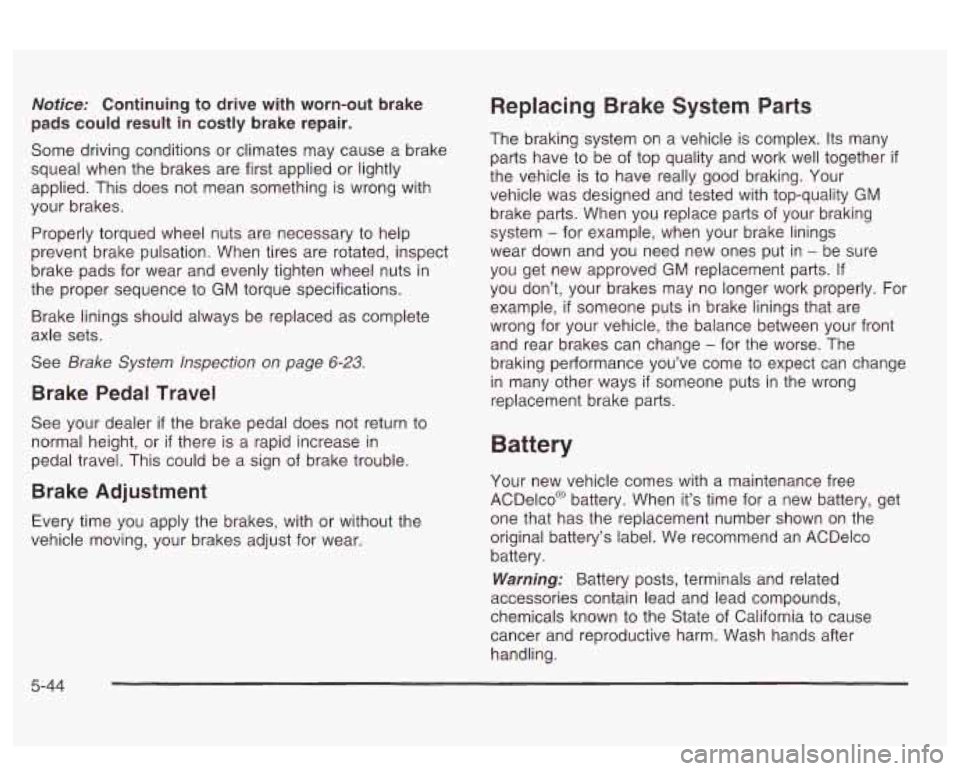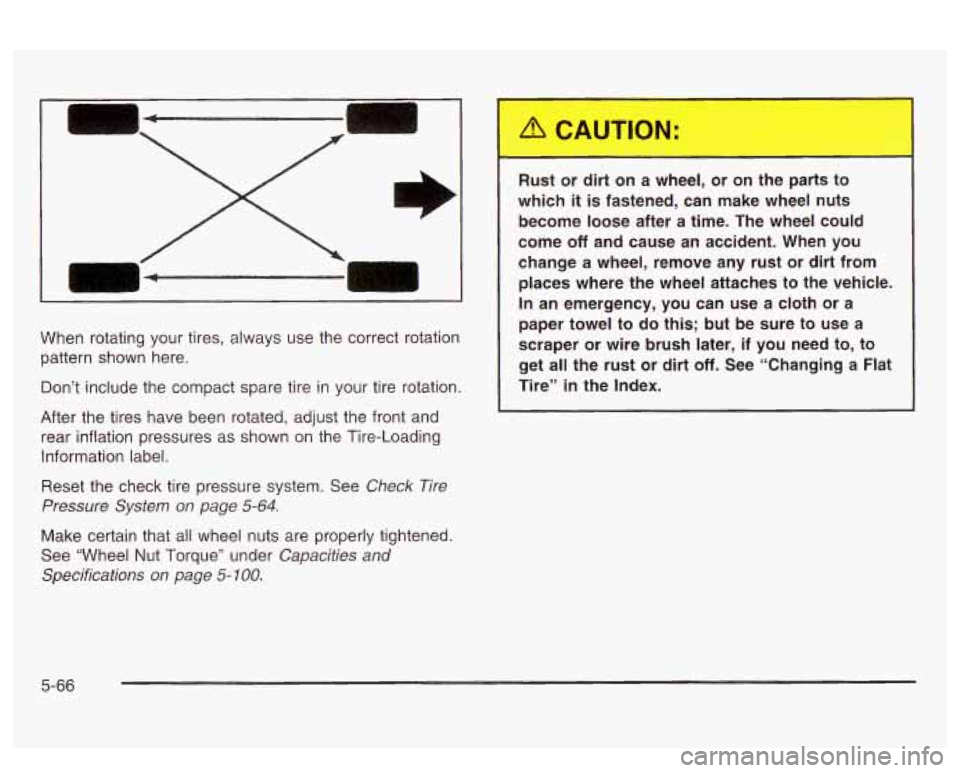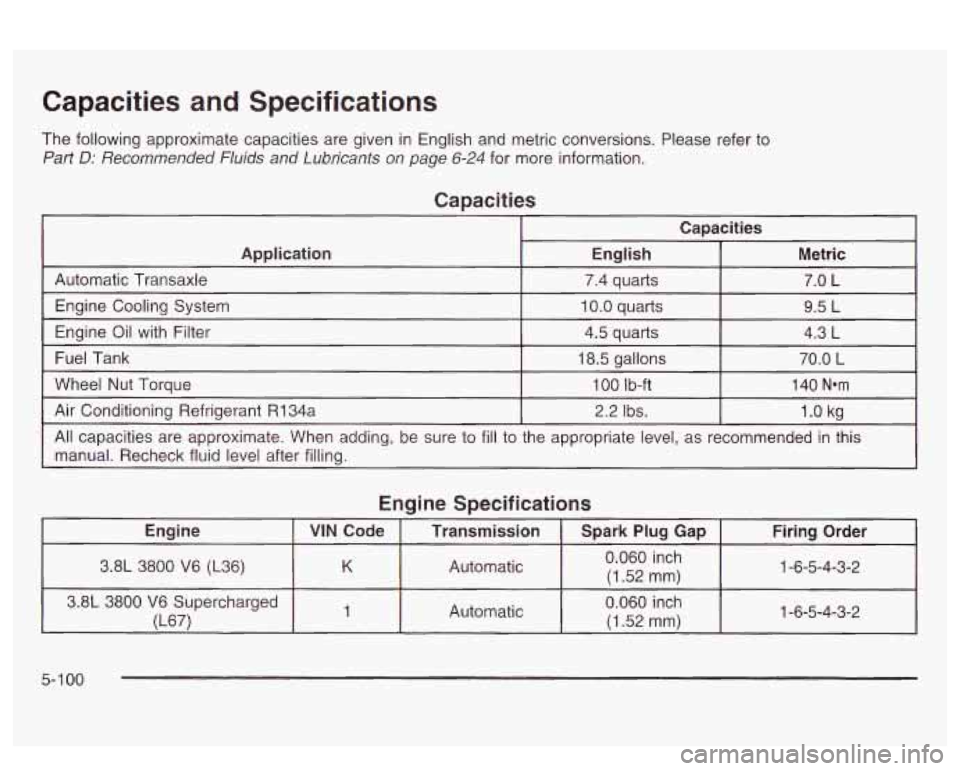2003 PONTIAC BONNEVILLE wheel torque
[x] Cancel search: wheel torquePage 303 of 418

Notice: Continuing to drive with worn-out brake
pads could result in costly brake repair.
Some driving conditions or climates may cause a brake
squeal when the brakes are first applied or lightly
applied. This does not mean something
is wrong with
your brakes.
Properly torqued wheel nuts are necessary to help
prevent brake pulsation. When tires are rotated, inspect
brake pads for wear and evenly tighten wheel nuts in
the proper sequence to GM torque specifications.
Brake linings should always be replaced as complete
axle sets.
See
Brake System Inspection on page 6-23.
Brake Pedal Travel
See your dealer if the brake pedal does not return to
normal height, or
if there is a rapid increase in
pedal travel. This could be a sign of brake trouble.
Brake Adjustment
Every time you apply the brakes, with or without the
vehicle moving, your brakes adjust for wear.
Replacing Brake System Parts
The braking system on a vehicle is complex. Its many
parts have to be of top quality and work well together
if
the vehicle is to have really good braking. Your
vehicle was designed and tested with top-quality GM
brake parts. When you replace parts of your braking
system
- for example, when your brake linings
wear down and you need new ones put in
- be sure
you get new approved GM replacement parts.
If
you don’t, your brakes may no longer work properly. For
example,
if someone puts in brake linings that are
wrong for your vehicle, the balance between your front
and rear brakes can change
- for the worse. The
braking performance you’ve come to expect can change
in many other ways
if someone puts in the wrong
replacement brake parts.
Battery
Your new vehicle comes with a maintenance free
ACDelco@ battery. When it’s time for a new battery, get
one that has the replacement number shown on the
original battery’s label. We recommend an ACDelco
battery.
Warning: Battery posts, terminals and related
accessories contain lead and lead compounds,
chemicals known to the State of California to cause
cancer and reproductive harm. Wash hands after
handling.
5-44
Page 325 of 418

When rotating your tires, always use the correct rotation
pattern shown here.
Don’t include the compact spare tire in your tire rotation.
After the tires have been rotated, adjust the front and
rear inflation pressures as shown on the Tire-Loading
Information label.
Reset the check tire pressure system. See
Check Tire
Pressure System on page
5-64.
Make certain that all wheel nuts are properly tightened.
See “Wheel Nut Torque” under
Capacities and
Specifications on page
5- 100.
Rust or dirt on a wheel, or on the parts to
which
it is fastened, can make wheel nuts
become loose after a time. The wheel could
come
off and cause an accident. When you
change a wheel, remove any rust or dirt from
places where the wheel attaches to
the vehicle.
In an emergency, you can use a cloth or a
paper towel to do this; but be sure to use a
scraper or wire brush later, if you need
to, to
get all the rust or dirt
off. See “Changing a Flat
Tire”
in the Index.
5-66
Page 338 of 418

11. Tighten the wheel nuts
firmly in a crisscross
sequence.
Incorrect wheel nuts or improperly tightened
wheel nuts can cause the wheel to come loose
accident. Be sure to use the correct wheel
nuts. If you have to replace them, be sure to
get new
GM original equipment wheel nuts.
Stop somewhere as
soon as you can and have
the nuts tightened with a torque wrench to
the
proper torque specification. See ”Capacities
and Specifications”
in the Index for wheel nut
torque specification.
~ and even come off. This could lead to an
Notice: Improperly tightened wheel nuts can lead
to brake pulsation and rotor damage.
To avoid
expensive brake repairs, evenly tighten the wheel
nuts
in the proper sequence and to the proper
torque specification. See “Capacities and
Specifications”
in the index for the wheel nut torque
specification.
12. Don’t try to put the wheel cover on the compact
spare tire. It won’t fit. Store the wheel cover in
the trunk until you have replaced the compact spare
tire with a regular tire.
Notice: Wheel covers won’t fit on your compact
spare. If you try to put a wheel cover on your
compact spare, you could damage the cover or the
spare.
When you reinstall the full size wheel and tire, you
install the wheel cover or nut caps at this point.
When reinstalling the nut caps on aluminum wheels,
continue tightening one-quarter turn for plastic caps,
or one-eighth turn for steel caps.
Do not overtighten.
*:-.LA-.- AI-- --_- -_..- ..,:&I- &L- ..,L--l .-,v-mah llylllell tile Lapa a11uy vvlu I 11 IG VVIIGGI VVIGII’CIII. I IIGI I
5-79
Page 359 of 418

Capacities and Specifications
The following approximate capacities are given in English and metric conversions. Please refer to
Part D: Recommended Fluids and Lubricants on page 6-24 for more information.
Capacities
Capacities
Application English Metric
Automatic Transaxle
7.4 quarts 7.0 L
Engine Cooling System
10.0 quarts 9.5 L
Engine Oil with Filter
4.5 quarts 4.3 L -
Fuel Tank 18.5 gallons 70.0 L
Wheel Nut Torque 1 00 Ib-ft 140 Nam
Air Conditioning Refrigerant R134a 2.2 Ibs. 1 .O kg
All capacities are approximate. When adding, be sure to fill to the appropriate level, as recommended in this
manual. Recheck fluid level after filling.
Engine Specifications
5-1 00
Page 413 of 418

Tilt Wheel ................. ............ 3-6
Ti re
Pressure Light
................ .................. 3-46
Tire inflation Check
......................................... 6-18
Ti res ................................... .......... 5.62. 5-87
Buying New Tires
....... ...................... 5-67
Chains
....................................................... 5-71
Changing a Flat Tire
.................................... 5-73
Check Tire Pressure System
......................... 5-64
Compact Spare Tire
..................................... 5-81
If a Tire Goes Flat ....................................... 5-72
Inflation
-- Tire Pressure ............................... 5-62
Inspection and Rotation
................................ 5-65
Uniform Tire Quality Grading
......................... 5-68
Wheel Alignment and Tire Balance
................. 5-69
Wheel Replacement
..................................... 5-69
When It
Is Time for New Tires ...................... 5-67
To Use the Engine Coolant Heater
.................... 2-28
Top
of the Instrument Panel ............................. 5-84
Top Strap
...................................................... 1-37
Top Strap Anchor Location
............................... 1-38
Torque Lock
................................................... 2-34
Total Weight on Your Vehicle’s Tires
.................. 4-38
Towing
Recreational Vehicle
..................................... 4-32
Towing a Trailer
.......................................... 4-36
Your Vehicle
............................................... 4-32
Control System (TCS)
.................................... 4-9
Control System Warning Light
....................... 3-43
Traction Traction
(cont.)
Low Active Light
...................................... 3-44
Trailer Brakes
................................................. 4-39
Trailer Wiring Harness
..................................... 4-39
Transaxle
Fluid. Automatic
........................................... 5-23
Transaxle Operation. Automatic
......................... 2-28
Transmission. Transaxle. Transfer Case Unit
Repair Manual
.............................................. 7-9
Transportation Options
...................................... 7-7
Trip Odometer
................................................ 3-38
Trunk
........................................................ 2-16
Trunk Ajar Light
.............................. .... 3-52
Trunk Lock Release
.................................... 2-16
Trunk Security Override
............................... 2-17
Turn and Lane-Change Signals
.......................... 3-7
Turn Signal/Multifunction Lever
........................... 3-7
Turn Signals When Towing a Trailer
.................. 4-40
Twilight Sentinel@
............................................ 3-15
U
Underbody Flushing Service ............................. 6-21
Understanding Radio Reception
........................ 3-99
Uniform Tire Quality Grading
............................ 5-68
United States
................................................... 7-3
Used Replacement Wheels
.............................. 5-70
Using Cleaner on Fabric .................................. 5-83
Using HomeLink@ ........................................... 2-45
14